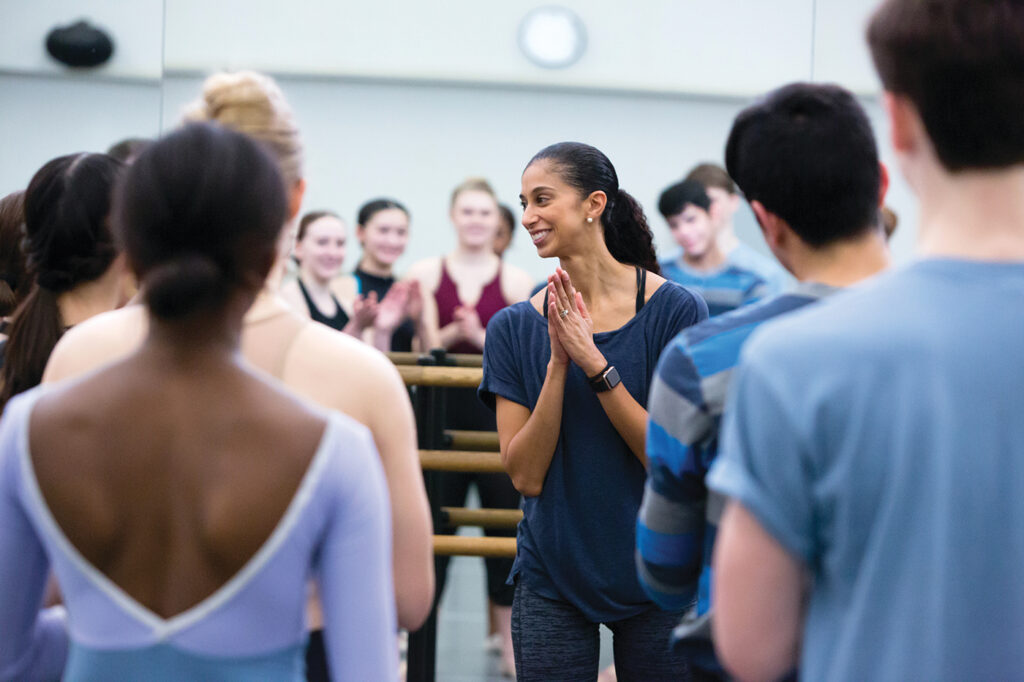Ballerina Alicia Graf Mack, the youngest-ever dean and director of the Dance Division of The Juilliard School, is posed on a stool at the Center of Creative Arts (COCA) in St. Louis. Soft light outlines her long neck and sets her braids aglow. Her hands lie relaxed in her lap, her features are composed, her back effortlessly straight. The camera is in position for a short documentary interview and — she hops down to hug a former student who just poked her head in the door.
“I follow you on Instagram!” says the young dancer, just back from New York.
“I follow you, too!”
A quick exchange, one more tight hug, and Mack returns to position. “Let me just tweak — no, that’s gorgeous,” the director says, surprised that his subject has managed perfect placement in two seconds.
She moves gracefully through the interview, answering every question conscientiously but with no empty words or clichés. Startled by how easy this was, the director wraps up fast.
“I’m a dean,” Mack tells him with a grin. She spends her days communicating, bringing the professional world of dance to Juilliard students and listening carefully to their dreams.
Her own began before she was 3 years old. Coming to work one day with her mother, she watched a dance class in another part of the building and got so excited, the teacher let her join while still in diapers. A few more years and Alicia knew, with a child’s unclouded certainty, that she had a superpower. Her body was so attuned to emotion that simply by the way she moved, she could move people’s hearts.
By age 12, she was dancing competitively. Posters of Judith Jamison, a star in the Alvin Ailey American Dance Theater, hung all over her room. At 17, she was accepted into the Dance Theatre of Harlem.
Co-founder Arthur Mitchell, “a disciplinarian and an amazing coach,” swiftly made Alicia Graf a soloist. Asked what he saw in her, she smiles. “Extensions. I had long legs I could lift to the sky. He would always ask me to do that.”
He saw more.
Graf reached for, and found, “a worldly, sensual cruelty” that delighted the reviewers. Dubbed “a born ballerina,” she was on her way to world-class.
Then the pain struck.
He cast her as the Siren in George Balanchine’s Prodigal Son. And when the role’s cruelty seemed impossible to an 18-year-old who radiated innocence and joy, Mitchell showed her video of Suzanne Farrell in Slaughter on Tenth Avenue, dancing against type. Possibilities broke open. Graf reached for, and found, “a worldly, sensual cruelty” that delighted the reviewers. Dubbed “a born ballerina,” she was on her way to world-class.
Then the pain struck.
Her knee had swollen many times before; doctors had drained the fluid and informed her that she was “too anxious,” her regimen too intense. This time, an MRI showed a tear in the cartilage — but after surgery to repair it, the knee did not heal. Then her ankle blew up, the tissue around that graceful joint swelling into a sphere. Her hip followed. Finally, her cousin, a rheumatologist, gave her the stunning diagnosis: ankylosing spondylitis, a rheumatoid disease.
She climbed into bed in her New York apartment and didn’t get up again. She couldn’t walk — and even if she could, where would she go? The sudden plummet from that early career high had shattered her. Alarmed, her brother moved in and made it his business to cheer her up. They ate a lot of Chinese takeout and watched a lot of comedies on TV.
From the apartment balcony, Graf could see the Columbia University campus. It looked like an oasis: all those people close to her age, carrying books that spelled various futures. She needed a new one.
She enrolled, majoring in history. For money, she wrangled an internship doing marketing for JPMorgan Chase, figuring this was her new life. But as soon as she graduated (with honors, and an offer to stay with JPMorgan Chase), Mitchell invited her back.
Her condition now managed, she danced with his company for a few more years, until the company hit a financial crunch. She called American Ballet Theatre but was told she was too tall. “You start in the corps, and they wanted everyone roughly the same height,” she explains. “I’m 5-foot-10, so en pointe I’m 6-foot-3.”
Ballet is infamous for its Procrustean insistence on certain body shapes; it had also been painfully white, its choreographers usually male, for decades. But Mitchell had shown her a freer, more inclusive approach. So had her parents. Her mother, who is Black, taught social work at Howard University; her father, who is white, was a community organizer. Different races, different temperaments, “as different as you can imagine,” she smiles. “That was the blueprint. You can lead this really rich life with diversity and inclusion when you let love lead the way.”
Ready to widen her own horizons, she joined the Alvin Ailey dance company, shifting to modern dance. After her debut, a reviewer for The New York Times wrote that she “was so good she became the news of the night all by herself.”
She danced with Alvin Ailey for three years, along the way falling in love with the cousin of a friend. They had met before, both history majors at Columbia. “You’re the new girl,” Kirby Mack said when she stepped on the elevator. Now, he was selling luggage, and traveling with Ailey had worn hers out. She asked him to find her a new large rolling duffel bag. Her roommate on tour, Antonio Douthit-Boyd (now artistic director of dance at COCA and teaching in its collaborative MFA program with WashU) saw it and wanted the same luggage. Mack wound up outfitting a few from the company.
“I owe you dinner or at least a drink the next time you’re in New York,” Graf told him.
“I’ll be in New York next week,” he replied. And after that first date, she knew he was the one.
For now, though, she was soaring again, her performances with Ailey making her talent obvious. In 2007, Smithsonian Magazine named Graf an American Innovator of the Arts and Sciences. But the following year, she crashed down with another injury.
It was back to school — this time Washington University, because it was in Mack’s hometown, and Graf felt happy on the peaceful campus. “I was surrounded by so many people who had big dreams, big goals,” she recalls. “And I needed a place that would also be healing.”
She enrolled in what was just renamed the School of Continuing & Professional Studies, which provided academic rigor and allowed her to work while she earned a master’s degree in nonprofit management. She also taught at WashU and at Webster University and was delighted to realize that she loved teaching, especially undergraduates: “They’re right on the precipice of their careers, and everything is urgent.”
A week after graduation, she married Mack. Now, she was set to teach — but once again, dance called her back. She rejoined Alvin Ailey in 2011 and danced three more years before another injury grounded her. In 2014, she retired.
In 2015, she and her husband had a son, Jay. Then came a daughter, Laila (who is her mom’s spitting image and already choreographing).
When Laila turned 2, the retired dancer heard about an opening at Juilliard. Urged to apply, she was hired. Now the family lives in New Jersey, and Alicia Graf Mack takes the train to Lincoln Center every morning to oversee auditions, curriculum, students, faculty, administration and the program’s relationship with professional dance. On family visits to St. Louis, she sees her friends from WashU, Webster, COCA.
This trip, after her interview is filmed, Mack visits a class, watching with her hands clasped behind her back as the young ballerinas do pliés. The thought was that she would give tips, but she hangs back, reluctant: “They don’t know me.” She would never dream of tucking an arm or extending a hand without someone’s permission. Not a fan of rigid corrections, she prefers to ask a student what they were thinking. If these were her students, though, she might tell them that a plié is “a moving meditation,” and when their arm curved in a port de bras, she might urge them to “gather the whole world with you.”
Every year, 400 applicants from all over the world audition at Juilliard; between 18 and 26 are accepted. They must have a keen sense of musicality (most teaching is done with live music, and communication is crucial); strong physicality (shape, form, coordination and endurance); a good understanding of technical specificity; and “something unique and intangible that will move an audience,” Mack explains — which is to say not by conforming to preordained standards, but through authentic self-expression.

“Why is something considered traditional; why is it part of the canon?” Mack wants students to ask. “Who is part of the canon?”
“We talk about why things have been as they are and how we want to see the dance world in the future,” she says. “More artists of color. More female choreographers. We’re trying to open the dancers’ minds so they question and think and discuss, which is not always something done in a dance studio but is important to us at Juilliard.”
The students who are accepted are not similar in terms of race, body type, background or even the sort of training they have had. Mack is determined to increase equity, diversity, inclusion and a sense of belonging, and this is more than rhetoric. Under her auspices, the program has put hip-hop in the core curriculum, added more instruction in West African dance and other world dance classes, expanded the coursework in composing (choreography), built in an elective course in technology and new media, and opened pointe classes to all genders.
Above all, she wants to shift the atmosphere, so that in a world traditionally closed and harshly critical, dancers can relax and feel like themselves — not judged, not forced to prove themselves because they are a certain shade or shape, driven only to be excellent.
Traditional ballet is traditionally romantic, an exaggeration, even, of masculine and feminine norms. But “dance, and how we interpret the world through dance, has to evolve with us,” Mack says. In classical ballet, “the dancing is beautiful, and the stories are universal,” she continues. “That’s why these ballets have lasted 150, 200 years.” What needs to change is only “who embodies them, who gets to tell these stories.”
Two men, dancing a love story — will one be able to lift the other? “Of course. You study, and you learn the technique. At Juilliard, we teach partnering, and we teach everybody to do everything.” Will the variations be as powerful? “Of course. Whenever you put deep love and passion onstage, you’re going to inspire an audience.”
Mack’s “life hashtag” is simple: “grace and grit.” Her definition of grace is striking because it extends well beyond the physical. “Someone who possesses grace,” she says slowly, “is someone who carries their pride — and their beauty, and their passion — with them always.” Those with that sort of grace, she adds, invariably also have grit. They know how to dig into the work.
What does it take to dance well? “You have to love the process, love the work,” she says. “The performance is the icing on the cake.” She misses that sweetness, though: “There’s nothing like performing on stage,” she admits. “It feels like your spirit is in motion.”
And what does it take to teach well? “You have to be a very astute listener. You have to have the awareness and flexibility to give each student what they need in the moment, not just teach all one way. You have to love how everything moves in small increments. You have to love.”







